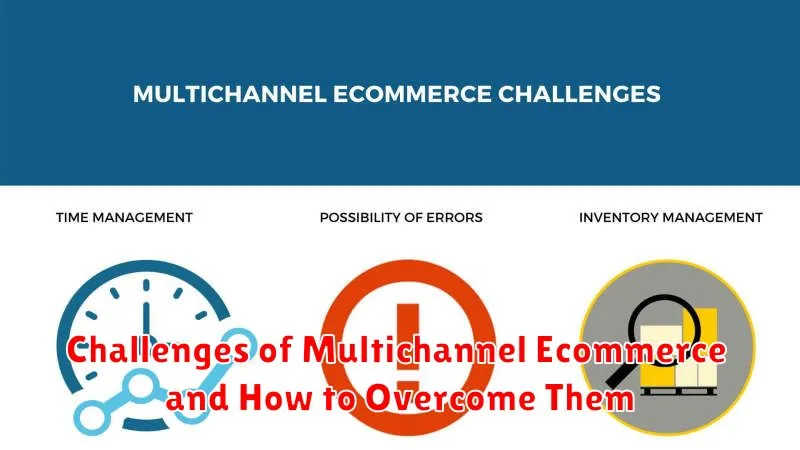In today’s digital age, consumers are more connected than ever, navigating seamlessly across various online platforms and channels. To succeed in this dynamic landscape, businesses need to adopt a multichannel approach, engaging customers wherever they are. Conquering the multichannel market is no longer an option but a necessity for any e-commerce business looking to thrive. This means creating a unified and consistent brand experience across all touchpoints, from social media and email marketing to online marketplaces and your own website.
This article will delve into the key strategies for building a successful e-commerce business in the multichannel market. We will explore essential elements like customer journey mapping, omnichannel marketing strategies, and seamless integration of various channels. By understanding and implementing these strategies, you can unlock the potential of the multichannel market and elevate your business to new heights.
Understanding Multichannel Ecommerce
In today’s digitally driven world, consumers have access to an abundance of choices and expect a seamless shopping experience across multiple channels. Multichannel ecommerce has emerged as a crucial strategy for businesses to thrive in this competitive landscape. It involves utilizing various channels, both online and offline, to reach customers, sell products, and provide exceptional service.
At its core, multichannel ecommerce goes beyond merely having a website and social media presence. It entails a holistic approach that integrates different touchpoints, including:
- Website: The primary online platform for product display, purchase, and customer interaction.
- Mobile Apps: Providing a convenient and personalized shopping experience on smartphones and tablets.
- Social Media: Engaging with customers, promoting products, and driving traffic to the website.
- Email Marketing: Nurturing customer relationships and promoting special offers.
- Physical Stores: Offering a tangible shopping experience and personalized customer service.
- Marketplaces: Expanding reach by leveraging platforms like Amazon, eBay, and Etsy.
By embracing a multichannel strategy, businesses can benefit from several advantages:
- Increased Reach: Targeting a wider audience by reaching customers across multiple channels.
- Enhanced Customer Experience: Providing a seamless and consistent shopping experience regardless of the chosen channel.
- Data Collection and Insights: Gathering valuable customer data from various channels to improve marketing and personalization efforts.
- Greater Flexibility: Adapting to changing consumer preferences and market trends.
- Increased Sales and Revenue: Leveraging multiple channels to drive more sales and revenue.
However, implementing a successful multichannel strategy requires careful planning and execution. Businesses must ensure seamless integration between channels, consistent branding across touchpoints, and a focus on providing exceptional customer service. By effectively integrating different channels, businesses can create a truly omnichannel experience, which further enhances customer satisfaction and loyalty.
Identifying Your Target Audience
Understanding your target audience is crucial for success in the multichannel market. It’s not just about selling products; it’s about building relationships and providing value to specific groups of people. The more you know about your customers, the better you can tailor your marketing efforts, product offerings, and overall brand experience to meet their needs and expectations.
Start by asking yourself fundamental questions about your ideal customer: Who are they? What are their demographics (age, gender, location, income)? What are their interests and hobbies? What are their pain points and challenges? What are their online behaviors and shopping habits? What platforms do they use? What are their motivations for buying?
Conduct thorough research using a combination of methods:
- Customer surveys and feedback
- Social media listening
- Website analytics
- Market research reports
- Competitor analysis
Once you have a clear picture of your target audience, create buyer personas, fictional representations of your ideal customers. These personas will help you visualize your target market and make informed decisions about your products, marketing strategies, and content creation.
Choosing the Right Ecommerce Platforms
In the dynamic world of multichannel e-commerce, choosing the right platform is paramount. It serves as the foundation upon which your online store will be built, influencing everything from user experience to scalability. To make an informed decision, consider these key factors:
Scalability: As your business grows, your platform should be able to accommodate increasing traffic, inventory, and order volumes. Look for platforms with flexible hosting options and the ability to integrate with third-party services.
Features and Functionality: Evaluate the features that align with your specific needs. Do you require advanced marketing tools, payment gateways, inventory management systems, or customer relationship management (CRM) integrations?
Ease of Use: Choose a platform that is user-friendly for both you and your team. Consider the learning curve, the availability of tutorials, and the level of technical expertise required.
Cost: Platforms vary in pricing models. Evaluate subscription fees, transaction fees, and any additional costs associated with themes, plugins, or custom development. Compare the overall value proposition in relation to your budget.
Security and Reliability: Your e-commerce platform should prioritize security and reliability. Look for platforms with robust security measures, regular updates, and reliable uptime. A secure platform protects your customers’ data and builds trust.
Support and Documentation: Ensure that the platform offers comprehensive support resources, including documentation, tutorials, and customer support. This is essential for resolving issues, maximizing platform functionality, and staying up-to-date with updates.
By carefully considering these factors, you can choose an e-commerce platform that aligns with your business goals, sets you up for success in the multichannel marketplace, and enables you to effectively manage your online store.
Creating a Seamless Customer Experience
In today’s multichannel market, it’s not enough to simply have a presence across multiple platforms. To truly succeed, you need to create a seamless customer experience that bridges the gap between channels and delivers a consistent and personalized experience, regardless of where the customer interacts with your brand.
Here are some key strategies to consider:
- Centralized Customer Data: A unified customer view is essential for providing personalized experiences. Integrate data from all your channels to understand customer preferences, purchase history, and interactions across all touchpoints.
- Consistent Branding and Messaging: Your brand voice, tone, and visual identity should be consistent across all channels. Customers should recognize your brand regardless of whether they’re interacting with your website, social media, mobile app, or physical store.
- Omnichannel Shopping Cart: Allow customers to start their purchase on one channel and continue it on another. A seamless shopping cart experience that syncs across devices and platforms enhances the customer journey.
- Personalized Recommendations: Leverage customer data to personalize product recommendations, promotions, and content. Tailored experiences create a sense of value and make customers feel understood.
- Unified Customer Support: Provide consistent support across all channels. Customers should be able to reach you easily through live chat, email, phone, or social media, and receive the same level of assistance regardless of the channel.
By focusing on these strategies, you can create a truly seamless customer experience that drives customer loyalty, increases conversions, and differentiates your ecommerce business in a crowded market.
Developing a Consistent Brand Identity
In the bustling multichannel marketplace, establishing a cohesive brand identity is crucial for standing out and capturing the attention of your target audience. A consistent brand identity is more than just a logo; it’s a holistic expression of your values, personality, and unique selling proposition across all your touchpoints. This includes your website, social media platforms, packaging, customer service interactions, and marketing materials.
Start by defining your brand’s core values, mission, and target audience. What makes you different from competitors? What problem do you solve for your customers? Once you have a clear understanding of your brand essence, you can develop a consistent visual identity that reflects your personality. This includes selecting a memorable logo, choosing a color palette, and establishing a consistent brand voice and tone.
Beyond aesthetics, it’s crucial to maintain consistency in your messaging across all channels. Ensure that your brand story and value proposition are communicated clearly and effectively, regardless of where your customers encounter your brand. Consistency fosters trust and recognition, making it easier for customers to connect with your brand and remember you amidst the overwhelming competition.
Developing a consistent brand identity requires dedication and ongoing effort. Regularly evaluate your brand presence across different platforms and make adjustments as needed. Be sure to involve all teams within your organization in maintaining a cohesive brand experience, from marketing and sales to customer service and product development. By nurturing a consistent brand identity, you can create a powerful and lasting impression in the competitive multichannel market.
Managing Inventory and Orders Across Channels
In the dynamic world of multichannel e-commerce, efficiently managing inventory and orders across multiple platforms is crucial for success. The ability to seamlessly track stock levels, fulfill orders promptly, and ensure a consistent customer experience across all channels is paramount.
Implementing a centralized inventory management system is essential for maintaining an accurate view of stock availability. This system should integrate with all sales channels, including your website, marketplaces, and social media platforms. By having a single source of truth for inventory data, you can avoid overselling and stockouts, which can lead to frustrated customers and lost sales.
Another critical aspect is order fulfillment. A robust order management system allows you to streamline the process of receiving orders, packaging, and shipping. This system should provide real-time order tracking capabilities for both you and your customers, ensuring transparency and satisfaction. Consider utilizing third-party logistics providers (3PLs) for fulfillment if you have high order volumes or operate in multiple locations. 3PLs can handle warehousing, picking, packing, and shipping, freeing up your time and resources to focus on other aspects of your business.
Maintaining a consistent brand experience across all channels is vital for customer loyalty. Ensure that your product descriptions, pricing, and shipping policies are uniform on all platforms. This consistency will help build trust with your customers and minimize confusion. Additionally, utilize customer relationship management (CRM) software to track customer interactions and personalize their experience across all channels.
Leveraging Data and Analytics
In today’s multichannel marketplace, understanding your customers and their behavior is paramount to success. Data and analytics provide the insights needed to make informed decisions about everything from product development to marketing campaigns. By leveraging this information, you can identify emerging trends, optimize your website and marketing efforts, and ultimately enhance the customer experience.
Customer analytics offer valuable insights into your target audience, including their demographics, buying habits, and preferences. This information can be used to segment your audience and personalize marketing messages for greater impact.
Website analytics track user behavior on your website, revealing areas for improvement. By analyzing data on traffic sources, bounce rates, and conversion rates, you can identify bottlenecks and optimize your website for better user experience and higher conversion rates.
Marketing analytics are essential for understanding the effectiveness of your campaigns. By tracking key metrics such as click-through rates, open rates, and return on investment (ROI), you can identify what’s working and what’s not, allowing you to refine your strategy and maximize your marketing spend.
By embracing a data-driven approach, you can gain a competitive edge in the multichannel market. Data and analytics empower you to understand your customers, optimize your operations, and drive business growth.
Optimizing Your Website for Multichannel Sales
In today’s dynamic digital landscape, embracing a multichannel approach is crucial for any eCommerce business to thrive. A well-optimized website acts as the central hub for your multichannel strategy, facilitating a seamless customer experience across various touchpoints.
1. Mobile Responsiveness: With a significant portion of online shopping happening on mobile devices, ensuring your website is fully responsive is paramount. This means adapting to different screen sizes and orientations, providing a smooth browsing experience for all users, regardless of their device.
2. User-Friendly Navigation: A clear and intuitive website navigation is essential for guiding customers effortlessly through your product catalog. Simple menus, logical category organization, and effective search functionality make it easy for visitors to find what they need.
3. High-Quality Product Images and Descriptions: Visually appealing product images and detailed, engaging descriptions are crucial for capturing customer interest. High-resolution images allow customers to examine products in detail, while comprehensive descriptions provide valuable information and address potential questions.
4. Secure Checkout Process: A streamlined and secure checkout process is vital for building trust and converting customers. Minimize form fields, offer multiple payment options, and ensure a secure connection with SSL encryption to protect sensitive data.
5. Integration with Other Channels: Your website should act as a central hub for managing and integrating your various sales channels. This includes connecting with social media platforms, marketplaces, and even physical stores to provide a unified customer experience.
6. Personalization and Targeting: Leverage customer data and analytics to personalize the website experience. This can involve tailored product recommendations, targeted promotions, and customized content based on user behavior and preferences.
By optimizing your website for multichannel sales, you create a seamless and engaging customer journey that drives conversions and builds long-term loyalty.
Running Effective Marketing Campaigns
In today’s multichannel market, reaching your target audience requires a strategic approach that extends beyond a single platform. Running effective marketing campaigns across multiple channels is crucial for driving brand awareness, engaging customers, and ultimately, boosting sales. Here are some key strategies for success:
1. Define Your Target Audience: Before launching any campaign, it’s essential to understand your target customer. Who are they? What are their interests and pain points? By identifying your ideal customer, you can tailor your messaging and channel selection for maximum impact.
2. Embrace Omnichannel Marketing: Create a seamless customer experience across all your channels. This means ensuring consistency in messaging, branding, and offers, whether a customer is interacting with your website, social media, email marketing, or even physical stores.
3. Leverage Data Analytics: Track your campaign performance and use data to optimize your strategies. Analyze website traffic, social media engagement, email open rates, and other metrics to identify what works best and make adjustments accordingly.
4. Personalize Your Messages: In a world of information overload, personalization is key. Leverage customer data to deliver tailored messages that resonate with individual preferences. This could include personalized email recommendations, targeted social media ads, or customized product suggestions on your website.
5. Optimize for Mobile: With the majority of internet users browsing on mobile devices, ensure your marketing campaigns are mobile-friendly. This includes responsive website design, optimized mobile ads, and mobile-friendly email formats.
6. Monitor and Adapt: The marketing landscape is constantly evolving. Stay informed about new trends and technologies, and adapt your campaigns to stay ahead of the curve. Continuously test, analyze, and refine your strategies to maximize your ROI.
By implementing these strategies, you can run effective marketing campaigns that reach your target audience across multiple channels, driving engagement, loyalty, and ultimately, business success.
Measuring Success: Key Metrics to Track
Navigating the multichannel market requires a keen understanding of your performance across different channels. To truly conquer this landscape, you need to track key metrics that illuminate your progress and identify areas for improvement. Here are some essential metrics to consider:
Website Traffic: Track the number of visitors to your website, the bounce rate (percentage of visitors who leave after viewing just one page), and the average session duration to understand user engagement. Analyzing traffic sources like organic search, social media, and paid advertising helps you understand which channels are driving the most valuable visitors.
Conversion Rate: This metric reveals how effectively you convert website visitors into customers. Monitor the conversion rate for each channel, product category, and marketing campaign to identify high-performing areas and optimize underperforming ones.
Customer Acquisition Cost (CAC): Calculate the average cost to acquire a new customer across all your channels. This provides valuable insight into the effectiveness of your marketing efforts and helps you identify opportunities to optimize spending.
Customer Lifetime Value (CLTV): This metric estimates the total revenue a customer generates over their lifetime. Focusing on increasing CLTV can significantly impact your overall profitability, as it encourages customer loyalty and repeat purchases.
Social Media Engagement: Monitor metrics like likes, shares, comments, and mentions on your social media platforms. This data reveals your brand’s reach and audience engagement.
Email Marketing Performance: Track open rates, click-through rates, and conversion rates for your email campaigns. This data helps optimize email content and timing to increase engagement and drive conversions.
By consistently monitoring these metrics, you gain valuable insights into your performance across different channels. This data-driven approach empowers you to refine your strategies, optimize your marketing efforts, and ultimately, conquer the multichannel market.
Benefits of Building a Multichannel Ecommerce Business

In today’s digital landscape, businesses are constantly looking for ways to reach their target audience and increase sales. One strategy that has proven to be highly effective is building a multichannel ecommerce business. This approach involves selling products across multiple platforms, including online marketplaces, social media, and physical stores. Here are some key benefits of adopting a multichannel strategy:
Increased Reach and Visibility: By selling on multiple platforms, you can reach a wider audience than you would by relying solely on a single channel. This is especially important in today’s competitive market, where consumers have a wide range of options at their fingertips.
Improved Customer Experience: Customers appreciate having multiple options for interacting with your business. By providing a multichannel experience, you can cater to different preferences and offer a seamless shopping experience.
Enhanced Brand Awareness: A multichannel approach can help you build brand awareness across different platforms. By engaging with customers on social media, showcasing products on marketplaces, and providing excellent customer service, you can reinforce your brand identity and create a lasting impression.
Data Collection and Insights: A multichannel strategy allows you to collect data on customer behavior across different platforms. This data can be used to gain insights into customer preferences, identify areas for improvement, and personalize marketing campaigns.
Increased Sales and Revenue: By reaching a wider audience and providing a more convenient shopping experience, a multichannel approach can significantly boost sales and revenue. This is because customers are more likely to make a purchase if they have multiple options and convenient payment methods available.
Improved Customer Loyalty: Offering a multichannel experience can foster customer loyalty by providing convenience and personalized interactions. This, in turn, can lead to repeat purchases and increased customer lifetime value.
In conclusion, building a multichannel ecommerce business offers numerous benefits for businesses of all sizes. By leveraging the power of multiple platforms, you can reach a wider audience, improve customer experience, enhance brand awareness, and ultimately drive growth and profitability.
Challenges of Multichannel Ecommerce and How to Overcome Them

The multichannel ecommerce landscape, while offering immense potential, presents a unique set of challenges for businesses seeking to thrive. Successfully navigating these hurdles is crucial for achieving sustainable growth and customer satisfaction.
One of the most prominent challenges is managing inventory across multiple channels. Maintaining accurate stock levels and preventing overselling can be a logistical nightmare. A robust inventory management system is essential, ensuring real-time updates and seamless synchronization across all sales platforms.
Another hurdle is ensuring a consistent customer experience. Customers expect a unified brand identity and seamless interaction regardless of the channel they choose. This requires careful planning and execution to ensure consistent messaging, branding, and customer service across all touchpoints.
Data integration and analysis can also be a challenge. Multichannel businesses often face data silos, making it difficult to gain a comprehensive view of customer behavior and optimize operations. Integrating data from different platforms and using advanced analytics tools is crucial for making informed decisions.
Overcoming these challenges requires a multi-pronged approach. Implementing a centralized platform for order management, inventory control, and customer data can significantly streamline operations. Investing in technology solutions that automate processes and improve efficiency is also essential. Furthermore, prioritizing customer feedback and continuous improvement is crucial for delivering a consistently positive experience.
By proactively addressing these challenges, businesses can leverage the power of multichannel ecommerce to reach wider audiences, boost sales, and build lasting customer relationships.
Future Trends in Multichannel Ecommerce

The multichannel ecommerce landscape is constantly evolving, and businesses need to stay ahead of the curve to thrive. Here are some key trends shaping the future of multichannel ecommerce:
Personalization: Consumers expect personalized experiences, from product recommendations to targeted marketing messages. Businesses will need to leverage data and AI to deliver personalized interactions across all channels.
Voice Commerce: Voice assistants like Alexa and Google Assistant are becoming increasingly popular, opening up new opportunities for ecommerce. Businesses will need to optimize their products and services for voice search and integrate with voice platforms.
Augmented Reality (AR) and Virtual Reality (VR): AR and VR technologies are transforming the way consumers shop by providing immersive experiences. Businesses can use AR to allow customers to visualize products in their own space and VR to create virtual showrooms.
Social Commerce: Social media platforms are becoming key shopping destinations. Businesses will need to embrace social commerce features, such as shoppable posts and live streaming, to reach customers where they are.
Omnichannel Fulfillment: Consumers expect seamless experiences regardless of where they purchase, whether online or in-store. Businesses need to invest in omnichannel fulfillment strategies that allow customers to buy online and pick up in-store, return items purchased online at a physical store, or receive same-day delivery.
By embracing these trends, businesses can create engaging multichannel experiences that meet the evolving needs of today’s consumers and pave the way for future success.
Case Studies: Successful Multichannel Ecommerce Businesses

The multichannel approach is no longer a trend; it’s a necessity for businesses to thrive in today’s digital landscape. But how do you know if it’s truly the right path for your ecommerce business? The answer lies in learning from successful multichannel brands who have paved the way. Here are some case studies of businesses that have effectively integrated multiple channels to maximize their reach and revenue:
Amazon is a prime example of a multichannel success story. They started as an online bookstore but expanded to encompass everything from physical retail stores (Amazon Go and Whole Foods) to digital services (Amazon Prime Video, Music, and Alexa). This diversification allows them to meet customers wherever they are, be it online, in-store, or through a smart device.
Nike has seamlessly transitioned from a traditional retail brand to a multichannel powerhouse. Their website offers a vast selection of products, while their physical stores provide a premium shopping experience. They also utilize social media and influencer marketing to connect with their target audience. Nike’s success lies in creating a unified brand experience across all channels, making it easy for customers to shop and engage.
Sephora excels at integrating online and offline channels. Their website is a go-to destination for beauty products, while their physical stores offer personalized services like makeup consultations and product demos. Sephora’s loyalty program connects the online and offline experience, encouraging customers to shop across both channels. This seamless integration allows them to cater to diverse customer needs and preferences.
These case studies demonstrate the immense power of a multichannel approach. By understanding the strategies employed by these successful businesses, you can draw inspiration and implement similar tactics for your own ecommerce venture.

